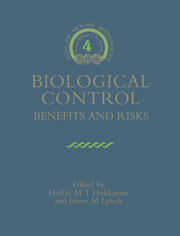Book contents
- Frontmatter
- Contents
- List of Contributors
- Series Preface
- Preface: Overview of Benefits and Risks of Biological Control Introductions
- Part I Biological Invasions
- Part II Classical Biocontrol
- 5 Benefits and Risks of Classical Biological Control
- 6 Potential Impacts on Threatened and Endangered Insects Species in the United States from Introductions of Parasitic Hymenoptera for the Control of Insect Pests
- 7 Lessons from Post-release Investigations in Classical Biological Control: The Case of Microctonus aethiopoides Loan (Hym., Braconidae) Introduced into Australia and New Zealand for the Biological Control of Sitona discoideus Gyllenhal (Col., Curculionidae)
- 8 Host Specificity Screening of Insect Biological Weed Control Agents as Part of an Environmental Risk Assessment
- Part III Augmentative Biocontrol
- Part IV Use of Genetically Modified Organisms
- Part V Economics and Registration
- Index
6 - Potential Impacts on Threatened and Endangered Insects Species in the United States from Introductions of Parasitic Hymenoptera for the Control of Insect Pests
Published online by Cambridge University Press: 07 May 2010
- Frontmatter
- Contents
- List of Contributors
- Series Preface
- Preface: Overview of Benefits and Risks of Biological Control Introductions
- Part I Biological Invasions
- Part II Classical Biocontrol
- 5 Benefits and Risks of Classical Biological Control
- 6 Potential Impacts on Threatened and Endangered Insects Species in the United States from Introductions of Parasitic Hymenoptera for the Control of Insect Pests
- 7 Lessons from Post-release Investigations in Classical Biological Control: The Case of Microctonus aethiopoides Loan (Hym., Braconidae) Introduced into Australia and New Zealand for the Biological Control of Sitona discoideus Gyllenhal (Col., Curculionidae)
- 8 Host Specificity Screening of Insect Biological Weed Control Agents as Part of an Environmental Risk Assessment
- Part III Augmentative Biocontrol
- Part IV Use of Genetically Modified Organisms
- Part V Economics and Registration
- Index
Summary
Introduction
Introductions of parasitic wasps have often led to economic control of introduced insect pests (Clausen, 1978). Biological control practitioners argue that such introductions have fewer and less severe detrimental impacts than alternative controls (DeBach and Rosen, 1992). However, others have challenged this viewpoint (Howarth, 1983, 1991) with the argument that introduced biological control agents can drive non-target populations extinct, especially if these are already rare. Others have responded that the impact on conservation of insects species is unlikely if introductions are done carefully (Samways, 1988). Unfortunately, this controversy has given rise to more heat than light, being plagued by excessive generalization, lack of hard data on adverse impacts, and lack of concrete recommendations about how to reduce the risks of introductions. The lack of data on adverse impacts arises, in part, because many biological control projects lack the funds for evaluating the impact of the introduced agent on the target species, let alone on non-target species. The low level of funding, relative to the complexity of the problems involved, also means that methods to reduce risks will have to rely heavily on extant knowledge, if biological control introductions are to continue. In this chapter, I will address the following questions: How can one predict the potential impacts on threatened and endangered insect species from introductions of parasitic Hymenoptera for the control of insect pests in the continental United States?; and, What are the potential impacts from selected introductions? I have chosen a narrow scope of impacts and types of introductions to avoid overgeneralization.
- Type
- Chapter
- Information
- Biological ControlBenefits and Risks, pp. 64 - 74Publisher: Cambridge University PressPrint publication year: 1995
- 4
- Cited by



